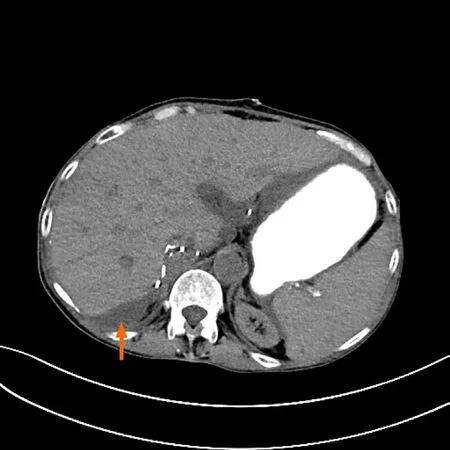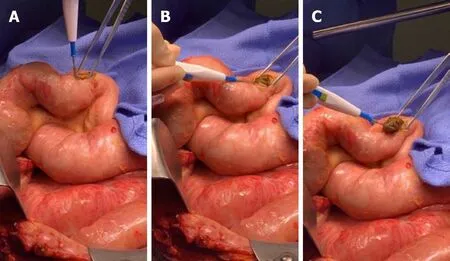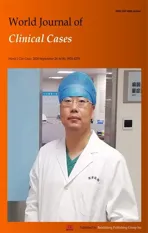Small bowel obstruction caused by a bezoar following an adult simultaneous liver-kidney transplantation:A case report
2020-04-08GilbertPanRobinKimJeffreyCampsenGeorgeRofaiel
Gilbert Pan,Robin D Kim,Jeffrey Campsen,George Rofaiel
Gilbert Pan,Robin D Kim,Jeffrey Campsen,George Rofaiel,Department of Surgery,Division of Transplantation and Advanced Hepatobiliary Surgery,University of Utah School of Medicine,Salt Lake,UT 84132,United States
Abstract BACKGROUND Small bowel obstructions(SBOs)are common following a large intra-abdominal operation;however,SBOs caused by bezoars are unreported in patients following liver-kidney transplantation procedures,particularly in adults.CASE SUMMARY A 65-year-old Caucasian female presented with nausea and nonbilious emesis during her postoperative course following a simultaneous liver-kidney transplantation.She developed worsening nausea and vomiting with significant abdominal distension and obstipation.Computed tomography imaging showed a marked abnormal dilation of multiple small bowel loops with a distinct transition point that was suggestive of a small bowel obstruction.An exploratory laparotomy revealed a foreign body in the intestinal track approximately 30 cm from the ileocecal valve.The foreign body was extracted and identified as a bezoar with hair follicles and old digestive contents.Following the operation,the patient demonstrated rapid clinical improvement with resolution of nausea,emesis,and progress in bowel motility.CONCLUSION SBOs caused by bezoars can occur immediately following a liver-kidney transplantation and should not be discounted as a diagnosis.
Key Words:Case report;Liver transplantation;Liver-kidney transplantation;Small bowel obstruction;Post-transplant complications;Transplantation
INTRODUCTION
Liver transplantation remains the standard of care for patients with end-stage liver disease(ESLD).As with all intra-abdominal procedures,there remains the risk of forming intra-abdominal adhesions in about 95% of patients[1].Small bowel obstructions(SBOs)are a common morbidity associated with abdominal surgery[2].Treatment modalities include both operative and nonoperative management.Conservative,nonoperative management typically consists of bowel rest,intravenous fluid rehydration,and nasogastric intubation[3].While most SBOs resolve without surgical intervention,an estimated 24% of SBOs require emergency surgery[4].Computed tomography(CT)scans remain a valuable tool to evaluate the etiology of the SBO as well as provide information to determine management strategies[5-7].
Bezoars are foreign bodies composed of undigested material that often persist in the gastrointestinal tract without causing obstructions[8].In fact,bezoars are a relatively uncommon form of SBO,affecting less than 4% of all cases[9].We are here presenting a case of a bezoar causing an acute SBO requiring operative intervention.This occurred shortly after a simultaneous liver-kidney transplant.
CASE PRESENTATION
Chief complaints
A 65-year-old Caucasian female developed persistent nausea and vomiting during her postoperative course approximately a week following a simultaneous liver-kidney transplantation.
History of present illness
Post-operative days 1 and 2 were notable for nausea and nonbilious emesis.Ondansetron was administered with gradual improvement and symptom resolution.About a week later,the patient developed worsening of nausea and vomiting with significant abdominal distension and obstipation.
History of past illness
The patient has a history of liver cirrhosis secondary to primary biliary cholangitis and subsequent end-stage renal disease.She also had a history of inflammatory bowel disease.She received simultaneous liver-kidney transplantation after being placed on the waiting list.Her model for end-stage liver disease score at the time of transplant was 25.The donor was a 62-year-old female who had an intraventricular hemorrhage and was declared brain dead.The liver enzymes were within normal limits,and the terminal creatinine was 0.66 mg/dL.The Kidney Donor Profile Index score was 87%.
The transplantation operation was performed using a standard Chevron incision for the liver transplant.The biliary reconstruction was performed using standard duct-toduct anastomosis.The incision was extended in a paramedian fashion on the right side to perform the kidney transplant.The recipient’s intraoperative course related to transplantation was uncomplicated.
Laboratory examinations
Laboratory examination results were within normal limits following a simultaneous liver-kidney transplantation.
Imaging examinations
Computed tomography(CT)imaging showed a marked abnormal dilation of multiple small bowel loops with a distinct transition point.This was suggestive of a small bowel obstruction(Figure 1).
FINAL DIAGNOSIS
Upon review of radiographic imaging,a small bowel obstruction was suspected that required immediate operative intervention.
TREATMENT
An exploratory laparotomy was performed.After examining the whole small and large intestine,a foreign body was found approximately 30 cm from the ileocecal valve.The bowel was subsequently opened,and the foreign body was identified as a bezoar with hair follicles and old digestive contents(Figure 2).The bezoar was extracted,and the bowel was closed using a side-to-side anastomosis.Pathology was notable for mild serosal reactive tissue without chronic features to suggest inflammatory bowel disease.
OUTCOME AND FOLLOW-UP
There were no known intraoperative complications.Following the removal of the bezoar,the patient demonstrated rapid clinical improvement with resolution of nausea,emesis,and progress in bowel motility.Patient remains asymptomatic with no evidence of bowel obstruction or food intolerance 10 mo after exploration.
DISCUSSION
Postoperative bowel obstruction is not an uncommon issue.The most common cause of bowel obstruction is adhesive disease[10].Foreign body related obstruction is more common in pediatric populations[11].It is however not described as a common cause in adults,especially in the immediate postoperative period[12].In our case,the patient was practically not eating before the symptoms of bowel obstruction became apparent.She actually started having evidence of bowel function and then regressed.Workup in these scenarios should proceed following standard of care for a mechanical obstruction.CT scans are typically very sensitive in indicating the area of obstruction and suggesting a possible partial obstruction,which usually resolves spontaneously.In this case,there was clearly a complete mechanical obstruction.Adhesive disease was the presumed diagnosis,but the foreign body bezoar was the unusual incidental finding.
Bezoars are commonly separated into 4 categories based on their composition:phytobezoars(fruit or vegetable content),trichobezoars(hair),lactobezoars(milk),and pharmacobezoars(medication)[13].Due to the narrow passage between the pylorus and small intestine,bezoars can cause an acute obstruction typically proximal to the ileocecal valve[14].Trichobezoars are commonly described in children with the most extreme cases often attributed to Rapunzel syndrome[15].Adult cases are uncommon and sparsely reported[16].Gross pathological analysis of the bezoar specimen showed hair follicles present;however,a definite diagnosis of a trichobezoar was not reached.
Limited reports exist about SBOs caused by bezoars in post-transplant settings.Schwarzenberg and colleagues discuss the management gastric bezoars after pediatric liver transplantation in a case series of 3 patients[17].Herein we present the management of an adult patient with SBO caused by a bezoar a week following a simultaneous liver-kidney transplantation.

Figure 1 Computed tomography imaging of patient with small bowel obstruction(arrow indicates area of obstruction).

Figure 2 Extraction of bezoar from small intestine.A:Enterotomy of small bowel;B:Identification of bezoar-caused obstruction;C:Extraction and removal of bezoar.
CONCLUSION
Liver transplantation is a necessary major intra-abdominal operation for ESLD patients.Complications occur that often require surgical intervention.In a posttransplant setting,reoperation is in a hostile setting that is fraught with risks and altered anatomy.The management of an adult with an SBO caused by a bezoar posttransplant is unreported,particularly immediately following the transplantation.This case discusses a post-operative anomaly that cannot be discounted for adult transplant recipients following a large intra-abdominal operation.
杂志排行
World Journal of Clinical Cases的其它文章
- Special features of SARS-CoV-2 in daily practice
- Gastrointestinal insights during the COVID-19 epidemic
- From infections to autoimmunity:Diagnostic challenges in common variable immunodeficiency
- One disease,many faces-typical and atypical presentations of SARS-CoV-2 infection-related COVID-19 disease
- Application of artificial neural networks in detection and diagnosis of gastrointestinal and liver tumors
- Hepatic epithelioid hemangioendothelioma:Update on diagnosis and therapy
